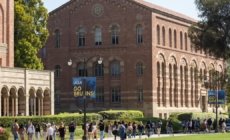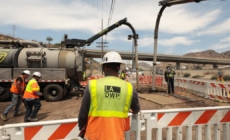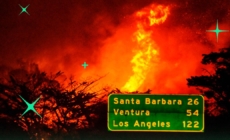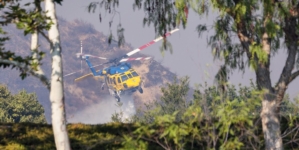-
Royals vs. Twins Highlights | MLB on FOX - 8 mins ago
-
Hate crime suspect arrested at UCLA after police find stolen posters, stun gun - 16 mins ago
-
Bulls, Josh Giddey Situation Receives a New Update - 23 mins ago
-
Kourtney Kardashian in hot water over picture of young son on boat - 25 mins ago
-
Yankees Manager Aaron Boone Ejected for 5th Time This Season in Game vs. Astros - 51 mins ago
-
DWP water repairs progressing as service outage continues - 56 mins ago
-
Indiana Fever Make Roster Move Following 2 Season-Ending Injuries - about 1 hour ago
-
Longest Field Goals in NFL History - 2 hours ago
-
Commentary: These nonfiction writers looked for the future of L.A. Did they find it? - 2 hours ago
-
How to Watch Washington Mystics vs Dallas Wings: Live Stream WNBA, TV Channel - 2 hours ago
#Strong is a recovery scam. California’s future demands something more
Joyce Birdwell survived the North Complex fire in 2020, though it devoured her home, and a life she loved, in the mountain town of Berry Creek.
Her partner, Art Linfoot, built the house they lost, a cabin with a wraparound porch and a year-round brook where deer drank and the sound of the water lulled the couple to sleep. Birdwell fired up her chain saw nearly every morning, she told me, aware that keeping the brush at bay was crucial for safety.
Los Angeles knows how to weather a crisis — or two or three. Angelenos are tapping into that resilience, striving to build a city for everyone.
But the fire that came through their Butte County home didn’t care about her trimmed trees, or her hard work or our persistent belief that everything will somehow be OK after a disaster. Birdwell, 69, and Linfoot, 80, are in Irvine now, with no intention of returning, or rebuilding.

Berry Creek Elementary School burned to the ground in the North Complex fire in 2020.
(Carolyn Cole / Los Angeles Times)
“I never thought twice about it as soon as we went back there and saw what was left,” she told me. “I know how long it takes for a tree to grow, and I just knew this would never, never work out for us.”
Hers is a bit of wisdom that is too often lost in our conversations about urban fire: Sometimes, recovery is not rebuilding. Politicians won’t admit it, but the ethos of #strong — measuring success with how quickly we can raise up houses on scorched earth — is snake oil, an emotional rallying cry that often delivers little more than a slippery bit of comfort that benefits the rich more than the rest. Because even rebuilding the most beloved of homes at the fastest of paces will not restore lives or communities to what they were. Or what they need to be. And by focusing on this powerful but narrow idea of recovery, we do a disservice to individual survivors and our collective good.
We need to change our understanding of what recovery is, because we live in an era when the climate crisis has created not just survivors, but refugees and migrants in California and the United States — and they deserve more than a slogan that, to steal a favorite phrase from our governor, does not “meet the moment.”
As we hurl forward to rebuild after January’s fires in the Palisades and Altadena — and all the disasters yet to come — it’s time to acknowledge that recovery and rebuilding, for all our talk, is never fair. There is a bias toward the rich embedded in the process. And for every recovery that we allow to be unfair under the guise of #strong, we march deeper to a California where the elite live in comfort and the rest live in fear — a rightful anxiety that everything we have is tenuous, given and taken as afterthoughts in a tug-of-war between Mother Nature and the wealthy.
‘Conspicuous resilience’
The idea that fire recovery is fair has always been a scam. In his infamous 1998 essay, “The Case for Letting Malibu Burn,” the much-revered and equally despised environmental activist and historian Mike Davis wrote that the “flatland majority” has always been paying “the ever increasing expense of maintaining and, when necessary, rebuilding sloping suburbia,” those rarefied neighborhoods that consider themselves part of Los Angeles proper only when they need something from the rest of us.
If that was true at the turn of the millennium, it’s even more so now.
When Davis wrote his controversial piece, he also noted that “late August to early October is the infernal season in Los Angeles.” More than three decades later, climate change has intensified our weather so much that floods and fires haunt almost every month of the California calendar, eclipsing the chthonic terrors of earthquakes that rattle us only now and then.
Summer Gray, an associate professor at UC Santa Barbara who studies the inequities in our responses to climate change, says disaster recovery can be “highly performative, often driven by more privileged members of the community” who have the money and clout that allow them to suck up resources. She saw this firsthand by examining recovery after the debris flows in Montecito in the wake of the 2017 Thomas fire.
Though talk in the ultra-wealthy enclave was all about community recovery, Gray concluded — through interviewing community members — that those with the ability to speak loudest and earliest often received more help, and set the agenda for what recovery included, and didn’t. She found that “narratives of resilience were actually obscuring systemic inequalities.”
Gray warns that sometimes, whether consciously or not, these privileged groups leverage “the optics of this collective recovery to accelerate their own rebuilding,” leaving working-class survivors “sidelined or ignored.” Gray calls this attitude part of “conspicuous resilience,” conflating being temporarily displaced and inconvenienced with being oppressed and vulnerable, leading to the celebration and glorification of a recovery that mostly benefits the few.
“I am not saying that our billionaire class has bad intent,” Gray said. But the elite, “don’t really understand what the needs are.”
My colleague Liam Dillon reported not long ago that before the fire, “the average home in Pacific Palisades cost $3.5 million, the median household earned $325,000 and the total number of rental units restricted as affordable housing was two.”
Two.
When Dillon asked former mayoral candidate and developer Rick Caruso, whose super-high-end mall is an anchor of Palisades commerce, if that should be expanded at this unique moment when everything must be rebuilt anyway, Caruso told him, “Now is not the time for outside groups with no ties to the area to slow down the ability of people to rebuild their homes by trying to impose their agenda.”

Two people ride past a burning house off Enchanted Way in the Marquez Knolls neighborhood of Pacific Palisades in January.
(Wally Skalij / Los Angeles Times)
No ties to the area except our tax dollars, of course, and our erstwhile equality as Angelenos and Californians.
Mayor Karen Bass’ now-ousted recovery czar, developer Steve Soboroff, who supported more affordable housing, put the mood more succinctly.
“We’re not rethinking,” Soboroff said. “We’re rebuilding.”
But if now is not the time to rethink, when is?
The climate crisis is costly, whipping up more and more disasters each year. When Davis wrote his book, there were about six natural disasters in the U.S. every year where the costs of recovery exceeded a billion dollars. Last year, there were 27. This year, we stopped counting, as part of government cost cutting, but that has not stopped floods, fires and heat waves.
Even if the federal government, largely through our taxes, was able to pick up the tab for every tornado, hurricane and wildfire, our current administration has made it clear it does not want to. The Federal Emergency Management Agency has been gutted, and may hand off many of its former duties to states, including California, that even if prosperous, lack the money to cover those costs.
Add to that the financial precariousness of tariffs that are making building more expensive, immigration policies that are decimating our construction workforce and insurance costs that are skyrocketing, if you can get a policy, and the prospect of the poor and middle class recovering from fire as quickly as the rich seems naive at best.
Fixes for the future
There are three actions we can take that have the potential to keep California from further devolving into climate rich and poor, housing winner and housing loser.
First, we need to end the fixation on speed.
“If it’s speed without a plan, it means you’re more likely to return to the status quo,” Laurie A. Johnson told me. She’s an urban planner who specializes in disaster recovery and a member of the Blue Ribbon Commission on Climate Action and Fire Safe Recovery convened by L.A. County Supervisor Lindsey Horvath.
Johnson views a focus on speed as “an empowerment of those who have everything they need, or who can easily get it.”

Volunteer archaeologists Elyse Mallonee, left, and Parker Sheriff carefully sift through rubble and ash while looking for cremated remains at a house in Altadena on Feb. 18.
(Myung J. Chun / Los Angeles Times)
Why don’t we acknowledge that fire destroys more than owner-occupied houses and give equal weight to graduation rates for affected students or the number of renters successfully relocated to safe apartments? What about measuring success around health outcomes for those with asthma or heart conditions exposed to the smoke, or count the number of people who feel their mental health needs have been met or their jobs stabilized?
Certainly home ownership is emotionally and financially important, especially in unique places such as Altadena where a Black middle class found refuge and economic security. But home ownership — and by extension rebuilding — is predominantly a measure of an upper-class recovery, especially in L.A. County, where less than half of the people own the place where they live.
It’s time to slow down, and, yes, rethink.
The second action that will help us reform how we handle disaster is even more difficult: Openly talk about who gets to recover with public money (which repaves roads and fixes water systems and sewers, for example) and who gets to decide who recovers with public money.
Returning to Davis’ point all those years ago, do we continue to rebuild in places that we know, for certain, will experience fire again? What do we owe places such as Malibu, where housing values have increased significantly with each post-fire rebuilding and which have made their elitism part of their identity? What do we owe places such as Altadena, if we allow homeowners with modest means to rebuild without robustly mitigating risk of a future fire?
Maybe not every place should be rebuilt. Maybe in some places, it’s time to let Mother Nature win, or at least create buffers so that she doesn’t have the upper hand.
Our better natures want to help everyone who faces loss, rich or poor. The idea that we would tell a community that they cannot have the money to restore themselves sounds like a political and moral absurdity. But it is increasingly likely that there simply will not be enough money in the future to rebuild everything.
To be honest, we are not rebuilding everything now, though we shove that truth out of our consciousness. Trump has already denied or delayed federal disaster aid to places including West Virginia and Washington state. North Carolina remains in crisis from its recent floods. And in the middle of both hurricane and fire season, FEMA recently proposed cutting $1 billion in grant funding for disaster preparedness and security, while at the same time allocating funds to build immigration detention centers.
It is absolutely time to impose a recovery “agenda” that takes into account the realities of climate change and our housing crisis and seeks to create communities that are safe and in service of our collective needs. Anything less ignores the reality of the majority, and nearly ensures that these places will return more gentrified, wealthier and even more exclusive, the exact opposite of what public dollars should support.

The Tahitian Terrace mobile home park, destroyed by the Palisades fire, is seen along Pacific Coast Highway in Malibu on Jan. 10.
(Zoe Meyers / AFP via Getty Images)
The last action we need to take to better face a difficult future is to expand what recovery means. It is not always rebuilding. More often than we like to acknowledge, it means moving on. But currently, few of our resources or even our conversations include help for those who don’t want to stick around. In fact, they’re often scorned or simply forgotten.
The Palisades fire wiped out 600 homes in Malibu, 5,500 overall. The Eaton fire destroyed more than 9,000 homes and buildings. Almost certainly, something will be built on all of those lots. Developers are already snapping some of them up. But almost as certain, many of the people who once lived in these places will not return — and probably shouldn’t.
Age, finances, health — there are myriad reasons why spending five to 10 years rebuilding a lost home is not the right decision. Recovery needs to support other options with government money, including moving elsewhere, without shame and without the pressure of the elite-driven #strong ethos that forces us to believe recovery looks like the past.
California’s best example of what this could include is the ReCoverCA Homebuyer Assistance (HBA) Program. This program gave financial assistance of up to $350,000 per household through a forgivable second mortgage loan to low- and middle-income folks, mainly renters, displaced by past fires — basically helping to buy houses for economically-challenged survivors.
The catch? The new home had to be outside a high-risk fire zone. That’s a win for displaced people, for the climate, and for encouraging safe housing and wealth building for the future. But the state is not currently funding the program for fire survivors, though some impacted by floods have a shot.
None of this is to argue that rebuilding is wrong, or that losing a home is undeserving of sympathy or help. It is. But there is so much more to survivors, and recovery, than a house.
Birdwell, who lost her home in Berry Creek, still thinks of that cabin as a “slice of heaven” and reminiscences “about how life used to be.” But she is left with anxiety — a remnant of the fire for which no one has offered her help — and a sense of dislocation and discontent. A few nights ago, she dreamed fire was coming at her again.
“I woke up, my heart was beating out of my chest,” she said. “That might be something that will happen the rest of my life.”
Her fire was five years ago, but like so many, her recovery is as incomplete as it is ignored. The conversation about Berry Creek still doggedly sticks to rebuilding.
In the next 30 years, we will assuredly have more climate refugees, more climate migrants, like Birdwell and Linfoot and the thousands of Angelenos still reeling from our recent fires. We can plan for that now if we choose to, leave behind the gratifying but false camaraderie of #strong and instead broaden our response to ensuring everyone who survives climate tragedy has options and equity.
If we don’t, we will simply move further into a future that bends recovery to benefit the wealthy, as Davis predicted long ago — prioritizing the rebuilding of hazardous communities again and again until the only people who can afford to live in them are the people who can afford to watch them burn.
Source link








































